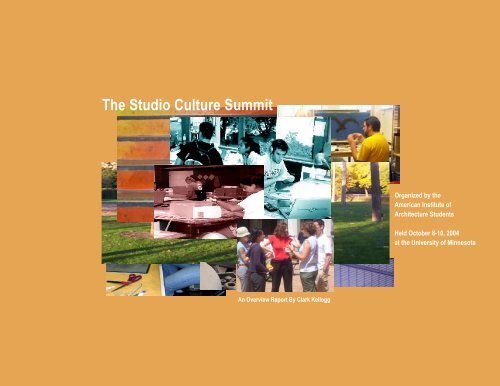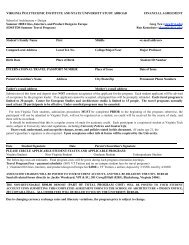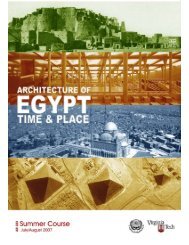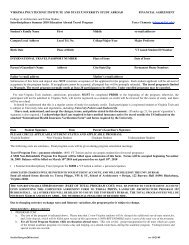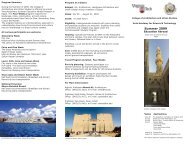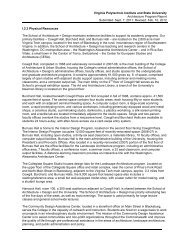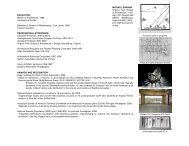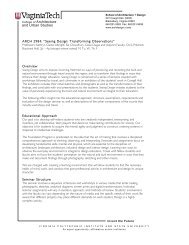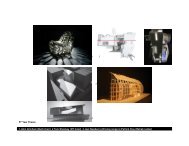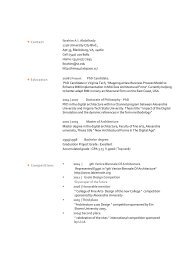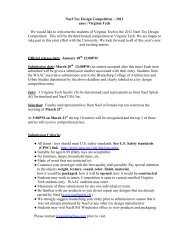The Studio Culture Summit - School of Architecture + Design
The Studio Culture Summit - School of Architecture + Design
The Studio Culture Summit - School of Architecture + Design
Create successful ePaper yourself
Turn your PDF publications into a flip-book with our unique Google optimized e-Paper software.
<strong>The</strong> <strong>Studio</strong> <strong>Culture</strong> <strong>Summit</strong>Organized by theAmerican Institute <strong>of</strong><strong>Architecture</strong> StudentsHeld October 8-10, 2004at the University <strong>of</strong> MinnesotaAn Overview Report By Clark Kellogg1
2“Architects must function atthe level that can fix the world.”– Richard Farson, Ph.D.President, Western Behavioral Science InstituteAddressing the <strong>Studio</strong> <strong>Culture</strong> <strong>Summit</strong>October 10, 2004
<strong>The</strong> <strong>Studio</strong> <strong>Culture</strong> <strong>Summit</strong>^<strong>The</strong> 2004 <strong>Studio</strong> <strong>Culture</strong> <strong>Summit</strong>was organized and produced by theAmerican Institute <strong>of</strong> <strong>Architecture</strong> Students (AIAS)with the generous support <strong>of</strong> these sponsors:<strong>The</strong> American Institute <strong>of</strong> ArchitectsAmerican Institute <strong>of</strong> <strong>Architecture</strong> StudentsAIA Large Firm RoundtableAIA MinnesotaAIA NebraskaArchVoices<strong>The</strong> Boston Society <strong>of</strong> ArchitectsTexas Society <strong>of</strong> ArchitectsUniversity <strong>of</strong> Minnesota College <strong>of</strong> <strong>Architecture</strong> and Landscape <strong>Architecture</strong>Funding for this publication was provided by <strong>The</strong> American Institute <strong>of</strong> Architects© 2005 American Institute <strong>of</strong> <strong>Architecture</strong> Students1
Astory has been told <strong>of</strong> an architecturestudent who lost his life in an automobileaccident caused by sleep deprivation. Adozen stories have been told <strong>of</strong> similarinstances. Thousands <strong>of</strong> stories havebeen told <strong>of</strong> cut fingers, damaged cars,life-changing critiques, friends lost and lives changed.All for an education in the art and science <strong>of</strong> architecture.<strong>The</strong>re is honor in providing shelter for the world. It iseasy to justify rigorous training for those who would beresponsible for such a solemn duty. Yet the education <strong>of</strong>an architect, as it has evolved, has too many stories <strong>of</strong>good people driven away or deeply wounded in the formalprocess <strong>of</strong> learning.In time, there were those who saw a pattern, a culture, inthese experiences and anecdotes. A product <strong>of</strong> the intensemodel developed to train great architects, this culture <strong>of</strong>tentook on characteristics <strong>of</strong> a punishing gamut servingthe establishment itself and not its students.<strong>The</strong>se words and these ideals touched institutions, studentsand educators throughout academia. In conventions,classrooms, and c<strong>of</strong>fee shops architecture students begantalking about the culture <strong>of</strong> architecture studio. Educatorsbegan researching and writing about studio in a verydifferent way.At the <strong>Studio</strong> <strong>Culture</strong> <strong>Summit</strong>, it was time to shift thefocus <strong>of</strong> academy-wide efforts to shape studio culture.This shift was clear. It went from a well-worn dialogue toresearch, innovation and proactive action. <strong>The</strong> <strong>Summit</strong>attendees left Minneapolis with nine directives thatdefine the next steps in the cultural shift surroundingarchitectural education.All cultures depend on stories passed on from one generationto the next. Because <strong>of</strong> the work <strong>of</strong> many goodpeople, including those who came to the <strong>Studio</strong> <strong>Culture</strong><strong>Summit</strong>, the stories that we tell <strong>of</strong> studio in the yearsahead <strong>of</strong> us will, I trust, hardly resemble those we oncetold.A few people began writing about these cultural issues.One notable effort was the publication <strong>of</strong> the AIAS <strong>Studio</strong><strong>Culture</strong> Task Force’s <strong>The</strong> Redesign <strong>of</strong> <strong>Studio</strong> <strong>Culture</strong>.<strong>The</strong>se people told <strong>of</strong> a better way; <strong>of</strong> a culture that isrespectful, optimistic, innovative, engaging and inclusive.– Jacob Day2004-2005 AIAS President2
ContentsSection 1<strong>The</strong> Context <strong>of</strong> the <strong>Summit</strong> .............................................4Section 2People Who Reached the <strong>Summit</strong> ..................................6Section 3ProceedingsA Critical Look at <strong>Studio</strong> <strong>Culture</strong> .................................10Provocative Perspectives ...........................................12Section 4OutcomesNine Initiatives ............................................................16Section 5EndpointsA Personal Viewpoint ..................................................22Print and Web Resources ...........................................243
<strong>The</strong> Context <strong>of</strong> the <strong>Summit</strong>From an AIAS Media Advisory released October 15, 2004Four provocateurs provided themesfor the <strong>Summit</strong> groups to discuss.Thomas Fisher, Assoc. AIA, Dean <strong>of</strong>the CALA, provided an overview <strong>of</strong>the history <strong>of</strong> architectural educationand the role <strong>of</strong> the design studio,highlighting the fact that the architecturestudio model has gone relativelyunchallenged and unchangedBoards), and expert speakers gatheredat the University <strong>of</strong> Minnesota in Minneapolison October 8-10, 2004 to discussthe role, impact, and future <strong>of</strong> designstudio-based education in architectureschools. <strong>The</strong> <strong>Studio</strong> <strong>Culture</strong> <strong>Summit</strong>built on the findings <strong>of</strong> the AIAS <strong>Studio</strong><strong>Culture</strong> Task Force report (<strong>The</strong> Redesign<strong>of</strong> <strong>Studio</strong> <strong>Culture</strong>, 2002). <strong>The</strong> <strong>Summit</strong>was organized by the American InstituteOver fifty students, educators, <strong>of</strong> <strong>Architecture</strong> Students (AIAS), hostedarchitects, leaders <strong>of</strong> the architecturalcollateral organizations <strong>Architecture</strong> and Landscape <strong>Architecture</strong>by the University <strong>of</strong> Minnesota College <strong>of</strong>(Association <strong>of</strong> Collegiate <strong>School</strong>s <strong>of</strong> (CALA), and facilitated by Clark Kellogg<strong>Architecture</strong>, <strong>The</strong> American Institute <strong>of</strong> <strong>of</strong> Kellogg Consulting/CommunicationArchitects, American Institute <strong>of</strong> <strong>Architecture</strong>Students, National Architectural Environmental <strong>Design</strong> at UC Berkeley.by <strong>Design</strong> © and teacher in the College <strong>of</strong>Accrediting Board and the National <strong>The</strong> <strong>Summit</strong> featured special presentationson key aspects <strong>of</strong> studio-based Council <strong>of</strong> Architectural Registrationeducationby recognized experts, followed bygroup discussion and break-out sessionscharged with documenting observationsand exploring opportunities for qualityimprovement in architecture studioexperience and education.since its inception in 1850 at theFrench Ecoles des Beaux Arts.Kathryn Anthony, Ph.D., Pr<strong>of</strong>essor<strong>of</strong> <strong>Architecture</strong> at University <strong>of</strong>Illinois at Urbana-Champaign, andauthor <strong>of</strong> <strong>Design</strong> Juries on Trial,presented the problems <strong>of</strong> studiobasedarchitectural education, theevaluation and jury process, and theimportance <strong>of</strong> students designingout <strong>of</strong> their comfort zones.4
Van B. Weigel, Ph.D., author <strong>of</strong> <strong>The</strong><strong>The</strong>ory <strong>of</strong> Global Development, remarkedon positive aspects <strong>of</strong> the design studioeducation model. He shared how thearchitectural design studio can beviewed as a constructivist playgroundand how technological communicationscan be used to enhance collaboration.Richard Farson, Ph.D., President <strong>of</strong> the<strong>The</strong> <strong>Summit</strong> utilized the breakoutgroups to critically analyze the issuespresented by the provocateurs to formulatea framework for the studio model,and to define its highest purpose. <strong>The</strong>participants focused on topics rangingfrom criteria to evaluate a design studio,the implementation <strong>of</strong> hybrid studios,the role <strong>of</strong> the studio within the largerWestern Behavioral Science Institute,spoke about the difference betweeneducation and training; and the importance<strong>of</strong> failure in achieving success ineducation, as well as the importance <strong>of</strong>architects taking up leadership roles insociety.architecture education curriculum, tothe value <strong>of</strong> the jury system and how itcan be better implemented. <strong>The</strong> participantsdeveloped a list <strong>of</strong> strategies forchange designed to assist the spectrum<strong>of</strong> institutions, organizations and pr<strong>of</strong>essionsthat are called on to implement orsupport changes over the next five years.5
<strong>The</strong> People Who Reached the <strong>Summit</strong>Ava Abramowitz, Esq., Hon. AIARepresentativeArchVoicesArnold Aho, AIAChair, Education CommitteeNational Council <strong>of</strong>Architectural Registration BoardsMatthew AldermanStudentNotre Dame UniversityKathryn Anthony, Ph.D. (Speaker)EducatorUniversity <strong>of</strong> Illinois at Urbana-ChampaignLeonard BachmanEducatorUniversity <strong>of</strong> HoustonMichiel Bourdrez, AIADirector, Pr<strong>of</strong>essional ServicesNational Council <strong>of</strong>Architectural Registration BoardsBrian ComerStudentJudson CollegeKen Crabiel, Assoc. AIA2003-2005 Board MemberNational Architectural Accrediting BoardPhoebe CrismanEducatorUniversity <strong>of</strong> VirginiaJacob Day2004-2005 PresidentAmerican Institute <strong>of</strong> <strong>Architecture</strong> StudentsRaymond Dehn, Assoc. AIAPresidentArchVoicesScott DietzEducatorSavannah College <strong>of</strong> Art & <strong>Design</strong>David OrrickStudentUniversity <strong>of</strong> NebraskaHelene Dreiling, FAIA, Hon. SDATeam Vice President<strong>The</strong> American Institute <strong>of</strong> ArchitectsRichard Farson, Ph.D. (Speaker)PresidentWestern Behavioral Sciences InstituteThomas Fisher, Assoc. AIA (Speaker)DeanCollege <strong>of</strong> <strong>Architecture</strong> & Landscape <strong>Architecture</strong>University <strong>of</strong> MinnesotaMatthew FochsStudentUniversity <strong>of</strong> Wisconsin - MilwaukeeThomas Fowler2004-2005 SecretaryAssociation <strong>of</strong> Collegiate <strong>School</strong>s <strong>of</strong> <strong>Architecture</strong>California Polytechnic State UniversitySan Luis ObispoMichael Geary, CAEExecutive DirectorAmerican Institute <strong>of</strong> <strong>Architecture</strong> StudentsAna Guerra, Assoc. AIA2004-2005 Board Member<strong>The</strong> American Institute <strong>of</strong> ArchitectFrank Guillot, AIA2004-2005 PresidentNational Council <strong>of</strong>Architectural Registration BoardsGabriella GutierrezRepresentativeAssociation <strong>of</strong> Collegiate <strong>School</strong>s <strong>of</strong> <strong>Architecture</strong>University <strong>of</strong> New MexicoMary GuzowskiEducator/ACSA RepresentativeUniversity <strong>of</strong> MinnesotaGene Hopkins, FAIA2004 National President<strong>The</strong> American Institute <strong>of</strong> ArchitectsBenedict IlozorEducatorHampton UniversityMatthew InnesEducatorArizona State UniversitySabir KahnRepresentativeAssociation <strong>of</strong> Collegiate <strong>School</strong>s <strong>of</strong> <strong>Architecture</strong>Georgia Institute <strong>of</strong> Technology6
Cory KamholzStudentUniversity <strong>of</strong> Wisconsin - MilwaukeeClark Kellogg (Facilitator)EducatorUniversity <strong>of</strong> California, BerkeleyPresident, Kellogg ConsultingRafael Longoria2004-2005 PresidentAssociation <strong>of</strong> Collegiate <strong>School</strong>s <strong>of</strong> <strong>Architecture</strong>University <strong>of</strong> HoustonCatherine LuxDirector <strong>of</strong> Member ServicesAmerican Institute <strong>of</strong> <strong>Architecture</strong> StudentsKatie MarcusStudentSouthern Polytechnic State UniversityThomas Mathison, FAIA2005 Vice President<strong>The</strong> American Institute <strong>of</strong> ArchitectsWilliam MillerEducatorUniversity <strong>of</strong> UtahMichael MirandaStudentWentworth Institute <strong>of</strong> TechnologyNorma Lizeth MoralesStudentTexas A&M UniversityRyan MurphyStudentSouthern Illinois UniversityJoel NelsonStudentUniversity <strong>of</strong> MinnesotaJoni PriestStudentJudson CollegeTim RiceInternHorty Elving & Associates, Inc.Kate Schwennsen, FAIA2005 1st Vice President<strong>The</strong> American Institute <strong>of</strong> ArchitectsMeenakshi SharmaStudentArizona State UniversityTrinity Simons, Assoc. AIA2004-2005 Vice PresidentAmerican Institute <strong>of</strong> <strong>Architecture</strong> StudentsBreanne SparrowStudentKansas State UniversityJim SullivanEducatorLouisiana State UniversityIan TabernerEducatorBoston Architectural CenterJustin TholenStudentUniversity <strong>of</strong> UtahVan Wiegel (Speaker)EducatorEastern UniversityAshley Wood2004-2005 Board MemberAmerican Institute <strong>of</strong> <strong>Architecture</strong> StudentsEric Zaddock2004-2005 Board MemberAmerican Institute <strong>of</strong> <strong>Architecture</strong> Students7
“We learned that architectural educationwas not a problem to be fixed, but apredicament to be massaged to health.”–Kate Schwennsen, FAIA2005 1st Vice President<strong>The</strong> American Institute <strong>of</strong> Architects8
3<strong>Studio</strong><strong>Culture</strong><strong>Summit</strong> Proceedings9
A Critical Look at <strong>Studio</strong> <strong>Culture</strong><strong>The</strong> people at the summit came from all overthe US. We ranged in age from under 20 toover 70. <strong>The</strong>y were students, architects, internarchitects, teachers, administrators, regulatorsand more. What did we have in common? All buttwo had been through design studio. Many werestill in studio as students or teachers.Everyone had powerful stories <strong>of</strong> their studioexperience. No one was indifferent. “<strong>Studio</strong>”has an enormous life-shaping influence onarchitecture students during one’s school yearsand throughout one’s life. This is true for theroughly half <strong>of</strong> architecture students who go onto work in the pr<strong>of</strong>ession as well as for the otherhalf who choose careers beyond architecture.1. Highest and Best Purpose <strong>of</strong> <strong>Studio</strong> Model:• Instill a lifelong method and passion for learning• A model for a habit <strong>of</strong> synthesis, so studio islinked to other courses and topics• Foster Community-based design• Allow students to discover their own “calling”• Instill and nurture creative discontent• Promote and support self-discovery• Support the development <strong>of</strong> personal identity• Instill respect and responsibility for living systems• To become a managed studio design processthat can be assessed and evolvedOne <strong>of</strong> the first thing we did as a group was workthrough our experience and knowledge <strong>of</strong> studioto create some grounded assessments aboutthe value and character <strong>of</strong> the design studios inAmerican schools <strong>of</strong> architecture. This evolvedinto four areas:10
2. Characteristics to Value and to Retain:4. Strategies for Change in <strong>Studio</strong> <strong>Culture</strong>:• Sense <strong>of</strong> community• Place specificity• Sense <strong>of</strong> mission• Mentoring (one-to-one)• Peer support• Romance and the “calling”• Critical thinking• Intense personal experience• Perseverance• 1-on-1 student/faculty integration• Multiple paths to teaching goals• Learn by doing• Holistic nature/synthesis• Presentation and explanation <strong>of</strong> why• Flexibility <strong>of</strong> instructors• Peer-to-peer learning• Group experience• Vertically integrated studios3. Characteristics to Discard:• Adversarial relationships• Lack <strong>of</strong> specific objectives• “All-nighter” myth and reality• Object-only focus <strong>of</strong> critiques• Distinction between talent and intelligence• Prizing final presentations too much• <strong>Studio</strong> overriding all other classes• Arbitrary (ungrounded) instructor criticism asvalid part <strong>of</strong> studio design process• Competitive insularity <strong>of</strong> individual projects• Competition vs. collaboration• Equating project value with personal value• <strong>Studio</strong>-based “star” culture• <strong>The</strong> “ordeal” <strong>of</strong> studio• Redundant studio projects• Dysfunctional traditions• Acknowledge change already occurring• Acknowledge change must continue• Share best practices• Awards for effective pedagogy• Discussion with studio faculty about changesthey’ve enacted/need to enact as part <strong>of</strong>accreditation team visits• Have faculty present their culture to students• Faculty work together to establish strategiesand outcomes for studios• ACSA teaching award program awardees asresource for peers and programs- assist in developing self assessment rubricfor evaluation <strong>of</strong> studio at multiple levels- develop a teaching program for new faculty- provide narrative <strong>of</strong> their learning strategies11
Provocative Perspectives<strong>The</strong> strongest conviction thatemerged from the <strong>Summit</strong> wasa universal endorsement <strong>of</strong> thedesign studio as a model for experience-basedlearning and skilldevelopment. <strong>The</strong> problems arenot inherently built into the studiomodel but are part <strong>of</strong> an insularlegacy culture that is changing andneeds to change more.<strong>The</strong> four provocateurs werebrilliant. Each brought insight,wisdom and hope. Together, theywove a compelling story <strong>of</strong> how wegot here, what isn’t working, whydesign studios are so powerfuland what we are called upon todo going forward.Thomas FisherPr<strong>of</strong>essor and DeanCollege <strong>of</strong> <strong>Architecture</strong> & Landscape <strong>Architecture</strong>University <strong>of</strong> Minnesota“Why We AreWhere We Are”“<strong>The</strong>re is nothing like focusingon the larger problems <strong>of</strong> theworld to put our problems inperspective, and I suspect thatonce we truly engage with theworld, many <strong>of</strong> the silly or selfdestructivetraditions <strong>of</strong> studiolife–the all-nighters, the obsessionwith grades, the ridiculouscompetition to see who can bethe most original–would disappearor seem irrelevant in light<strong>of</strong> these larger purposes.”12
Kathryn AnthonyEducatorUniversity <strong>of</strong> Illinois at Urbana-ChampaignVan WeigelEducatorEastern UniversityRichard FarsonPresidentWestern Behavioral Science Institute“Open Critique<strong>of</strong> the <strong>Studio</strong>Model”“Technologyand Innovationin Education”“Leadershipin Education”“Some parts <strong>of</strong> the studio modelhave changed over the lastdecade. <strong>The</strong> individual abusivebehavior is no longer common.What remains are underlyingstructural issues that stillthreaten the health <strong>of</strong> the studiomodel. It is still too insulatedfrom the rest <strong>of</strong> the world. It isstill too subjective. We are justbeginning to institute changessystematically. <strong>The</strong> job is notdone.”“<strong>The</strong> design studio is pedagogicallysolid. Thinking is an art.<strong>Studio</strong> focuses students onbecoming knowledge creatorsand knowledge integrators. <strong>The</strong>environment <strong>of</strong> studios allowthis to happen in the presence<strong>of</strong> more skilled persons aswell as fostering learning frompeers. <strong>The</strong> problems with studiosmostly stem from thehistorically insular nature <strong>of</strong>most architecture schools.”“<strong>The</strong>re is a big difference betweentraining and education.Training makes people alike.Education is threatening; it demandsyou be the best you can.Architects are really working inthe area <strong>of</strong> human affairs. Weneed to see things in a largercontext. <strong>Design</strong> has the capacityto create a better world but theworld is running out <strong>of</strong> time.”13
“Three days, fifty plus pr<strong>of</strong>essionals andstudents, all talking about studio culture...not only did ideas get passed and possiblesolutions get proposed, but connectionsaround the nation were made and changeswere set into place. <strong>The</strong> work done thatweekend ensured that the studio culture<strong>of</strong> our past will not be the future <strong>of</strong> ourpr<strong>of</strong>ession.”– Matthew FochsUniversity <strong>of</strong> Wisconsin-Milwaukee14
4<strong>Studio</strong> <strong>Culture</strong><strong>Summit</strong> Outcomes15
Outcomes<strong>The</strong> attendees <strong>of</strong> the <strong>Studio</strong><strong>Culture</strong> <strong>Summit</strong> charged thestakeholders, particularly theAIAS, to focus their efforts on nineinitiatives generated at the summit.<strong>The</strong>se nine initiatives encompassa range <strong>of</strong> issues and goals. <strong>The</strong>yrespond to the inherent complexity<strong>of</strong> this phenomenon we know as“studio culture.” Drawing from theideals presented in <strong>The</strong> Redesign<strong>of</strong> <strong>Studio</strong> <strong>Culture</strong> and from workat the summit, these initiativesapproach studio culture with a callfor direct communication, clearpolicy, rigorous research and arenewed belief in the value <strong>of</strong> thestudio model itself.<strong>The</strong> intention <strong>of</strong> the people at thesummit and the subsequent design<strong>of</strong> the initiatives are clear. Both areadvocates <strong>of</strong> changing studio cultureand doing so using collaboration,research and innovation.<strong>The</strong> AIAS is acting as “quarterback”for these initiatives. However, theAIAS recognizes it cannot succeedworking alone. It is collaborationthat will create positive, substantialresults. <strong>The</strong> AIAS will partner withACSA, NAAB, AIA, NCARB and othersto achieve these goals. Workingtogether, we can accomplish each<strong>of</strong> these initiatives and createsustainable change. Change thatwill indisputably benefit students,educators, the pr<strong>of</strong>ession and thepublic we serve.16
C O M M U N I C A T I O NI N I T I A T I V E SCommunicate Outcomes Share <strong>Studio</strong> Policy Resources Award SuccessesDisseminate outcomes andResearch and share a databank<strong>of</strong> methodologies used 3 sity <strong>of</strong> studio cultures amongHonor the success and diver-1 information regarding the 2proceedings <strong>of</strong> the <strong>Summit</strong>and provide resources relatedto studio culturein creating studio culture policies,as per NAAB Conditionfor Accreditation 3.5.degree-granting programsnationwide.• Fall 04: AIAS News Release• Fall o4: ArchVoices Issue• Spring 05: <strong>Studio</strong> <strong>Culture</strong> <strong>Summit</strong>Publication distributed. A summary <strong>of</strong>the <strong>Summit</strong> proceedings and a referencefor the dialogue that took place there.Outlines current and future status <strong>of</strong><strong>Studio</strong> <strong>Culture</strong> initiatives and advocacyefforts.• Summer 05: <strong>Design</strong> Intelligence supplement,Focus on the Future, dedicated to<strong>The</strong> <strong>Studio</strong> <strong>Culture</strong> <strong>Summit</strong> and studioculture.• Summer 04: NAAB Board <strong>of</strong> Directorscreate Condition 3.5 for Accreditation.Condition states schools are expected todemonstrate a positive and respectfullearning environment through theencouragement <strong>of</strong> the fundamentalvalues <strong>of</strong> optimism, respect, sharing,engagement and innovation betweenand among the members <strong>of</strong> its faculty,student body, administration and staff.• Spring 06: AIAS will survey selectschools on their methodologies forcreating the studio culture policy.• Fall 06: AIAS will compile those methodologiesand provide them as a resourceto schools preparing to write a policy.• Summer 06: <strong>The</strong> AIAS will form a taskgroup to create an award which willhonor strong and positive studio culturein architectural program communities.• Winter 07: Award launched.• Summer 07: First award conferred.17
R E S E A R C HI N I T I A T I V E STrack <strong>Studio</strong> Trends Create Assessment Tools Study <strong>Studio</strong> SettingsSurvey architecture programsDefine a system <strong>of</strong> assessmentthat represents perfor-6 developing models for “hybridResearch and aid in4 and collect studio culture policiesto understand system-widemance indicators for studio.studios” which join physical5trends influencing studio culture.and virtual studios.• Summer 06: AIAS will begin work ona survey that will gather information onstudio culture from students, faculty, andadministrators from programs across thecountry.• Fall 06: Initial test survey completed byan accredited university.• Winter 07: Results analyzed with thehelp <strong>of</strong> ACSA and research pr<strong>of</strong>essionals.• Spring 07: AIAS will develop a survey togo out to all programs.• Summer 06: AIAS will assemble ateam <strong>of</strong> pr<strong>of</strong>essionals, educators, administratorsand students in a task groupto discern the means <strong>of</strong> assessmentin studio including both ‘grading’ andcourse assessment.• Fall 06: Task group will researchvarious assessment methods.• Summer 07: AIAS will publish findingsand facilitate further discussion andpotential uses.• Summer 05: AIAS will study examples<strong>of</strong> studio settings, including those thatcombine virtual space and digital communicationwhile maintaining a physicalstudio center.18
S T U D I OI N I T I A T I V E SPromote Citizenship Engage Communities Expand <strong>Studio</strong> Model7Utilize the studio as theEncourage and promotePromote and providepremier place to teach architecture8 examples <strong>of</strong> studios and 9 resources about the studiostudents their ethicalobligation to become active,engaged citizens.studio educators who engagecommunities in projects.learning model for otheracademic settings includingK-12, interdisciplinary studies,and business.• Summer 07: Task group <strong>of</strong> experts willbe convened to debate and draft a criteriaand process for employing the studio asthe premier place to develop the ethics,responsibilities, skills and practices <strong>of</strong>design-based leadership. This effort willbe informed by the submissions <strong>of</strong> architecturalpapers, journals, and other forms<strong>of</strong> research supporting the studio as theoptimum environment for learning andpracticing leadership skills.• Summer 07: Task group <strong>of</strong> studentsand educators is convened to discuss anddraft a paper highlighting examples <strong>of</strong>studios engaging their communities. Thiseffort will be combined with submissionsto local and national media, architecturalpapers, journals, and other publicationssupporting this type <strong>of</strong> engagement.• Summer 08: Resources will be publishedarticulating the power <strong>of</strong> thestudio model as an effective learningenvironment. <strong>The</strong>se efforts will be atool for understanding the power <strong>of</strong> thestudio model, and architectural educationas well as the abilities <strong>of</strong> graduates<strong>of</strong> the nation’s architecture schools.19
“Masterfully conceived, spectacularlydelivered. A very engaging, provocative,forward-looking conference that willmove the pr<strong>of</strong>ession toward creatinghigher quality architects.”– Thomas Mathison, FAIA2005 AIA Vice President20
5<strong>Studio</strong> <strong>Culture</strong><strong>Summit</strong> Endpoints21
A Personal ViewpointLike most <strong>of</strong> us, I wentthrough design studio inarchitecture school. It wasa formative experiencefor me; I survived - eventhrived. Some <strong>of</strong> my closestfriendships were made there. <strong>The</strong> studiohad been a home, probably too much <strong>of</strong>one. Many years have passed by sincethen, but I still have vivid memories <strong>of</strong>those years in studio.Now, I teach in the same school in whichI studied architecture. Returning there as ateacher restimulated old studio memories.I find myself telling my students storiesabout when I was in the same studios.In the intervening decades, some <strong>of</strong> theromance has worn <strong>of</strong>f but the stingingcomments from certain critics haven’t.<strong>The</strong> ridiculous hours now seem insane.While teaching one day, I was drawing agraph on the blackboard <strong>of</strong> the “EmotionalLife <strong>of</strong> a <strong>Design</strong> Project.” It plotted - in apseudoscientific manner - the emotionalroller-coaster ride <strong>of</strong> the student experiencein design studio projects. I describedthe novice’s almost certain confusionbetween the value <strong>of</strong> the design and thevalue <strong>of</strong> the designer. I became engrossedin the lesson and illustrated the mainpoints with examples from my own timein studio. Telling these stories out loudmade them very lucid and personal. I feltlike I was a student back in studio. Whathappened next surprised me. When Ifinished the diagram and turned back t<strong>of</strong>ace the class, most <strong>of</strong> them were in tearsand I was close to it.It was astounding to realize so little hadchanged in the intervening 30 years.It was even more astounding when Ithought about all the things that hadchanged: PC’s, digital drawings, theWeb, globalization, CAD and CAM, 3-Dmodeling, Earth Day, Watergate, MyaLin, cloning, <strong>of</strong>f-shore drawings, ZahaHadid, mobile phones, the Euro, virtualeverything, along with Frank Gehry,Rem Koolhaus and global warming. Howcould the world outside studio change sopr<strong>of</strong>oundly and studio change so little?I was bewildered. So when the AIASasked me to facilitate the <strong>Studio</strong> <strong>Culture</strong><strong>Summit</strong> I said yes without hesitating.That was almost a year ago. Sincethen I’ve probably had one hundredconversations about studioand its culture. I’ve talked with students,teachers, practitioners and administrators.I’ve reviewed all the “usual suspects” inthe literature from the “Boyer Report”, toKathryn Anthony’s <strong>Design</strong> Juries on Trial,to (<strong>Summit</strong> attendee) Leonard Bachman’sand Christine Bachman’s promising newsoon-to-be-published research, “StudentPerceptions <strong>of</strong> Academic Workload inArchitectural Education.”Some things haven’t changed in the debateabout studio culture: people don’t agree.What has changed is the tone and content<strong>of</strong> the conversation. Early in our discussionsabout the summit, Jacob Day saidto me, “For four years the AIAS has beentalking about <strong>Studio</strong> <strong>Culture</strong>. A questionmy predecessors <strong>of</strong>ten heard was, ‘Whatare you complaining about? We wentthrough studio and we turned out fine–what’s the problem?’ ”At the <strong>Summit</strong>, people were asking differentquestions: What is the value <strong>of</strong> studioas a teaching model? How can we betterteach the teachers who lead studio courses?How can studios make a difference inreal-world projects? How will improvingstudio culture improve the pr<strong>of</strong>ession <strong>of</strong>architecture?22
<strong>The</strong>se are fundamentally different–and better–questions. <strong>The</strong>se are notthe questions <strong>of</strong> “the whining class”as one practitioner I spoke with describedthe <strong>Summit</strong> attendees. Instead, these arequestions that go to the heart <strong>of</strong> how weteach, inspire and nurture succeedinggenerations who will apply designerlythinking and design skills to a wide array<strong>of</strong> complex challenges in–and as the datademonstrates–far beyond, the currentpractice <strong>of</strong> architecture.<strong>The</strong> <strong>Studio</strong> <strong>Culture</strong> <strong>Summit</strong> produced nineinitiatives that, over the next five years,can shape and inform these questions.<strong>The</strong>y might even lead to answering some<strong>of</strong> them. But, no matter what, the <strong>Summit</strong>changed the conversation from complainingabout the past to designing the future.As facilitator, I saw 50 people–none <strong>of</strong>them whining–look squarely at studioculture and conclude that the model hasimmense value as a teaching environment;one-to-one communication, rich peer-topeerlearning, Socratic discourse, iterativeprogression, learning by doing, visuallyliterate, and creatively based.Those same people recognized that theculture <strong>of</strong> studio, with its roots in 18thcentury France, has elements that do notserve the needs <strong>of</strong> 21st century life and21st century architecture in America.To their credit, the <strong>Summit</strong> participantsdidn’t issue manifestos, opinions orungrounded assessments about studioculture. Instead, they called for thingsthat have been noticeably lacking inthe studio culture debate: doing betterresearch, defining best practices, communicatingabout things that matterand calling for action-based cooperationamong the five collateral organizations.It’s hard to know what will become<strong>of</strong> these initiatives. If the history <strong>of</strong>change in the pr<strong>of</strong>ession is a guide,these ideas may just be left to quietly diefrom neglect.But maybe this time it will be different.Maybe the confluence <strong>of</strong> students, teachers,practitioners, and wise outsidersthat came to the <strong>Summit</strong> and produced ablueprint for insight and action signals adifferent direction. Maybe they saw anewthe potential for design to improve theworld. Maybe they believe that “surviving”studio is not the best outcome tobe had from the core experience <strong>of</strong> anarchitectural education. Or perhaps theycaught a whiff <strong>of</strong> the ether reserved onlyfor the change-makers.I hope the future is different. I hope it’sdifferent for students whose self-esteemhas been crushed by abusive studio critics.I hope it’s different for teachers whosepassion for bringing forth the best <strong>of</strong> ouryoung people has been swept away by theinertia <strong>of</strong> institutional bureaucracy.I hope it’s different for the practicing architectswhose conviction wilts in the face<strong>of</strong> choosing between making change andmaking a living.Finally, I hope it’s different for the publicwe serve. <strong>The</strong> accelerating complexity<strong>of</strong> life on earth requires the highest andbest use <strong>of</strong> the remarkable knowledge andskills we learn. Maybe I’m crazy, but I stillbelieve we can make the world a betterplace. During the three days <strong>of</strong> the <strong>Summit</strong>,I was sure <strong>of</strong> it.– Clark Kellogg<strong>Studio</strong> <strong>Culture</strong> <strong>Summit</strong> Facilitator23
<strong>The</strong> <strong>Studio</strong> <strong>Culture</strong> <strong>Summit</strong>^Printand WebResourcesYou can find more information and linksto many <strong>of</strong> the works cited below on theAIAS <strong>Studio</strong> <strong>Culture</strong> <strong>Summit</strong> Web site atwww.aias.org/studiocultureBrief History <strong>of</strong> AIAS work on <strong>Studio</strong> <strong>Culture</strong> issues:November 2000 – AIAS establishes a <strong>Studio</strong> <strong>Culture</strong> TaskForce to study effects <strong>of</strong> current architectural educationpractices on students and consider alternatives. <strong>Studio</strong> <strong>Culture</strong>is brought to the forefront <strong>of</strong> the AIAS Advocacy agendaDecember 2002 – <strong>The</strong> Redesign <strong>of</strong> <strong>Studio</strong> <strong>Culture</strong> waspublished as the product <strong>of</strong> the AIAS <strong>Studio</strong> <strong>Culture</strong> TaskForce’s research. It is authored by then AIAS Vice PresidentAaron Koch, current AIA First Vice President KatherineSchwennsen, FAIA, then <strong>Studio</strong> <strong>Culture</strong> Task Force Chair,Deanna Smith and Thomas Dutton.July 2004 – NAAB creates a 13th Condition for Accrediation(Condition 3.5) requiring schools to have a written policyregarding the culture in their studio environments.October 2004 – <strong>The</strong> AIAS and the University <strong>of</strong> Minnesotahost the <strong>Studio</strong> <strong>Culture</strong> <strong>Summit</strong> as a forum for a heightenedlevel <strong>of</strong> dialogue among those with interests in the shape <strong>of</strong>studio life and architectural education.Selected Additional Resources:“<strong>The</strong> Past and Future <strong>of</strong> <strong>Studio</strong> <strong>Culture</strong>.” By Thomas Fisheravailable at ArchVoices.org. 10.15.04 newsletterAmerican Institute <strong>of</strong> Architects (AIA). “<strong>The</strong> Client Experience,”2002. Washington: American Institute <strong>of</strong> Architects, 2002.Boyer, Ernest, and Lee Mitgang. Building Community: A NewFuture for <strong>Architecture</strong> Education and Practice. Princeton, NJ:Carnegie Foundation for the Advancement <strong>of</strong> Teaching, 1996.Cramer, James P., and Scott Simpson. How Firms Succeed: AField Guide to <strong>Design</strong> Management. Atlanta: Greenway Communications,2002.Fisher, Thomas. In the Scheme <strong>of</strong> Things: Alternative Thinkingon the Practice <strong>of</strong> <strong>Architecture</strong>. Minneapolis: University <strong>of</strong> MinnesotaPress, 2000.“Patterns <strong>of</strong> Exploitation.” Progressive <strong>Architecture</strong>. May 1991:9.Monaghan, Patrick. “<strong>The</strong> ‘Insane Little Bubble <strong>of</strong> Nonreality’That Is Life for <strong>Architecture</strong> Students.” <strong>The</strong> Chronicle <strong>of</strong> HigherEducation. June 2001.Swett, Richard Nelson. “Leadership By <strong>Design</strong>.” ArchVoices.orgTemkin, Jody. “For Would-Be Architects, Grad <strong>School</strong> Like BootCamp.” <strong>The</strong> Chicago Tribune. January 6, 2002.24
written and designed by clark kellogg25
26<strong>The</strong> <strong>Studio</strong> <strong>Culture</strong> <strong>Summit</strong>^American Institute <strong>of</strong> <strong>Architecture</strong> Students1735 New York Avenue, NWWashington, DC 20006-5292202.626.7472email: mailbox@aias.orgweb: www.aias.org


